 December 1, 2022
December 1, 2022 Sichuan, China
Sichuan, China
On December 1, 2022, the 2nd International Seminar on Water Culture, co-hosted by the China Institute of Water Resources and Hydropower Research (IWHR), UNESCO, and the Sichuan Dujiangyan Water Conservancy Development Center, was successfully held both virtually and offline. With the theme "Water and Environment in Ancient Civilizations - Traditions, Technologies, and Culture," the seminar aimed to reflect President Xi Jinping's important directives on culture and to promote the implementation of the 14th Five-Year Plan for Water Culture Development initiated by the Ministry of Water Resources. It encouraged deep reflections on the relationship between water, society, and the environment.
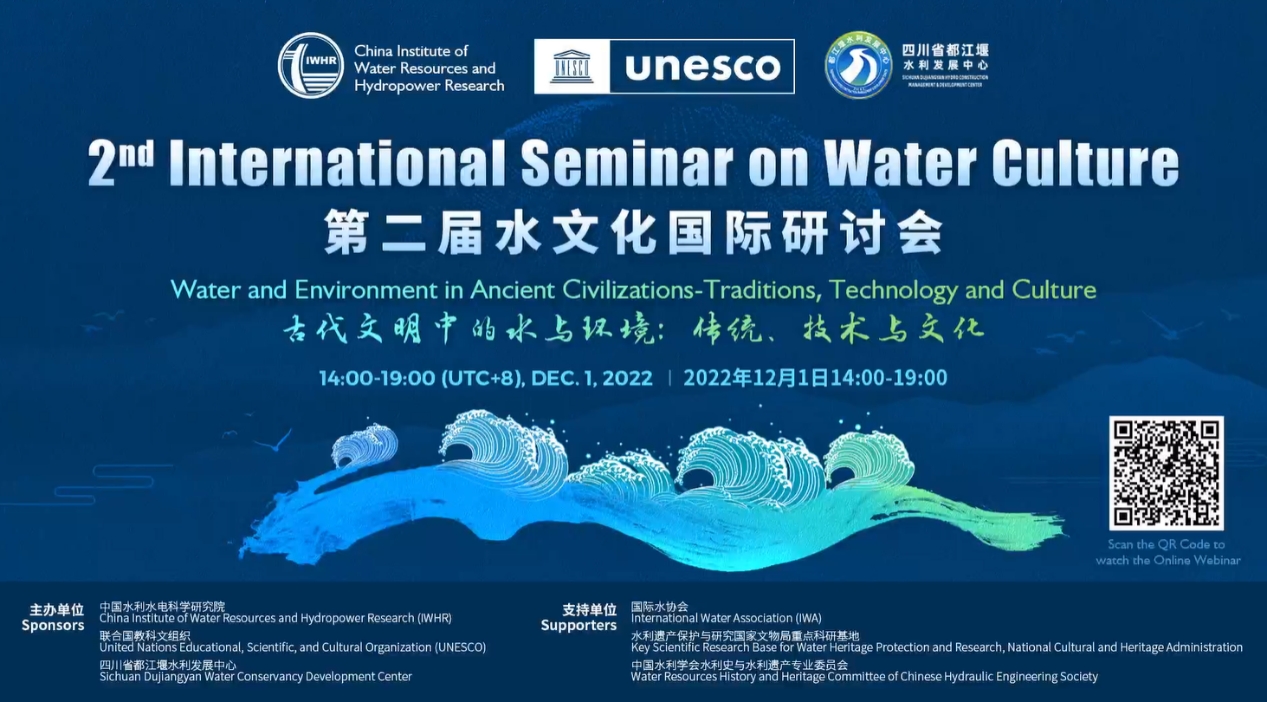

Li Ge emphasized that President Xi Jinping regards the outstanding traditional Chinese culture as the cultural root of the Chinese nation. The thousands of years of Chinese history, in many ways, represent a history of water management. The cultures nurtured in the Yellow River, the Yangtze River, and the Grand Canal have witnessed the origin, prosperity, integration, accumulation, and inheritance of Chinese civilization, which include profound thoughts on the relationship between water, the environment, and its sustainable development. This year, the Ministry of Water Resources issued the 14th Five-Year Plan for Water Culture Development, which focuses on the protection, inheritance, promotion, and utilization of water culture, fostering integrated and high-quality water development in the new stage. He expressed his hope that international organizations, research institutions, and universities would share their understanding and practices of water culture to draw from historical wisdom and neighboring experiences for building a beautiful planet and fostering sustainable development for humanity.
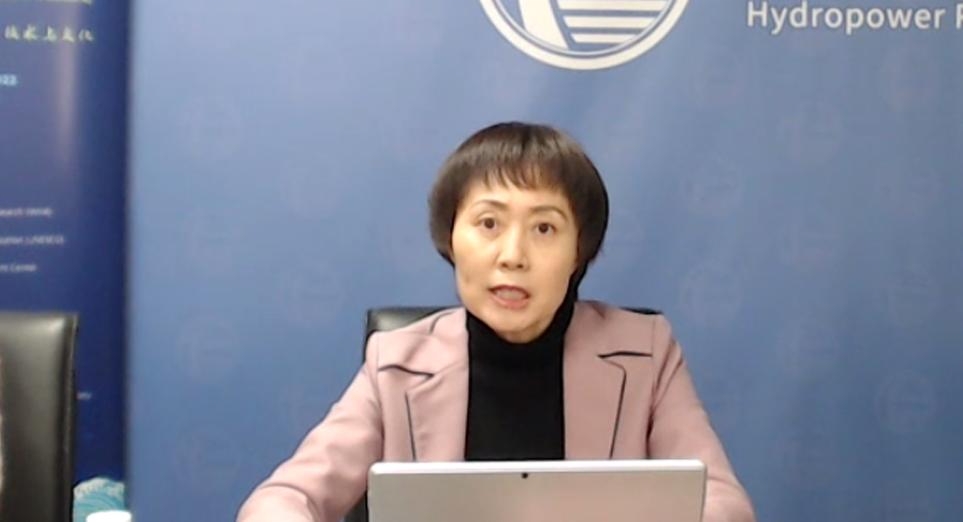
Peng Jing noted that water culture represents the spiritual values and lifestyle shaped by water. She quoted Lao Tsu's words over 2,000 years ago: "The highest good is like water. Water benefits all things without contending with them," reflecting the refined spiritual values and way of life inherent in Chinese water culture. The mission of IWHR is to inherit and innovate water culture. To this end, IWHR has long been dedicated to water culture infrastructure construction, research, and world heritage protection, contributing to the global inheritance and development of water culture. Peng Jing emphasized that water culture is a shared treasure of human civilization. She expressed hope that the seminar would establish a platform for international exchange on water culture, promoting its sustainable development and fostering the rich, diverse water cultures of humanity.

Abou Amani fully affirmed the seminar's theme and the discussions. He stressed that in facing today's global water challenges, countries should make science-, nature- and evidence-based decisions while learning from solutions of ancient civilizations. He also highlighted the need for a shift in the relationship between humanity and water, advocating for increased public education on water knowledge and the use of historical wisdom to collaboratively create a better future.


Daniela Bemfica remarked that water is the foundation for the harmonious coexistence between humans and the environment. With global challenges facing water resources, water environments, and water security, countries must adopt an unprecedented attitude to enhance cross-disciplinary, cross-sectoral, and cross-border collaboration to realize knowledge and information sharing in water culture. She thanked IWHR, UNESCO, and the Dujiangyan Water Conservancy Development Center for organizing the seminar and expressed IWA's eagerness to collaborate with China.
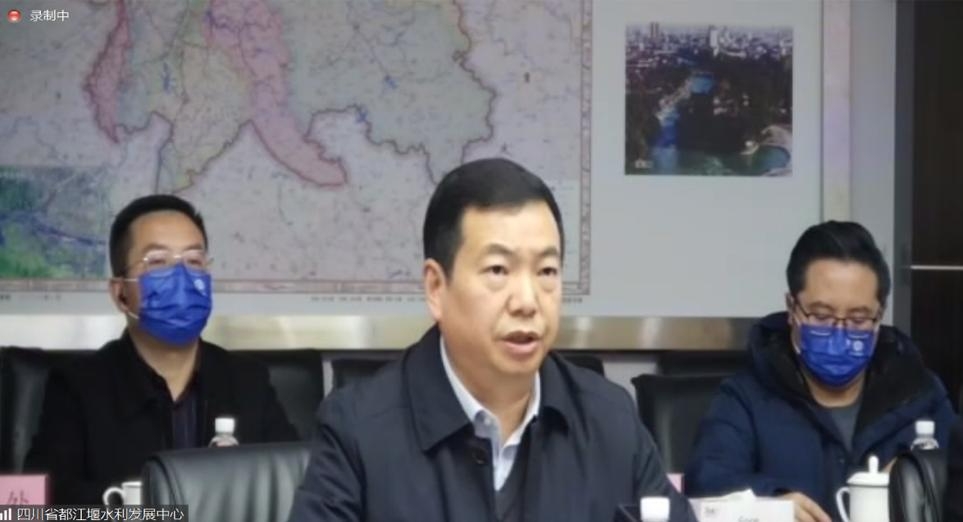
Zhu Zehua described Dujiangyan as the lifeblood of Chengdu, known as "the Land of Abundance." It is the world's most successful dam-free irrigation project and a symbol of harmonious coexistence between humans and nature. The rich philosophy, governance ideas, scientific expertise, and values it embodies, along with the national sentiment it invokes, are treasures in the history of China's water management and development. Zhu expressed that the Dujiangyan Water Conservancy Development Center will strengthen communication and cooperation with water culture organizations, social groups, and experts worldwide to further explore the utilization, inheritance, and protection of Dujiangyan's water culture heritage and to build it into an exemplary irrigation area of "international fame and domestic excellence."
During the keynote presentations, experts and scholars in water culture from China, Greece, France, Croatia, and other countries delivered technical reports. They focused on topics such as ancient water technologies, water civilizations and water heritage, water culture development in various countries and regions, and the historical development of water governance regulations, exchanging research findings on water culture from different nations and ethnic groups.

The development of ancient Greek hydrology bears significant relevance to modern hydrology. Thales, regarded as the father of natural philosophy and science, made remarkable contributions across various fields. Following Thales, Hippocrates discussed the relationship between water and health, describing the hydrological cycle; Heraclitus outlined the nature of natural hydrology; and Aristotle explained certain hydrometeorological phenomena, recognizing the perpetual alternation between land and sea. Aristotle also made important contributions to the Nile Paradox, attempting to address it from a scientific perspective. Subsequently, several scientists emerged, such as the librarian of Aristotle’s library, who attempted to validate Aristotle's theories by calculating distances across several sites on the Nile and creating maps. Another scientist, Hipparchus, was the first to introduce the term "climate," derived from the Greek word for "slope," indicating the dependence of climate on seasons, with "slope" representing the angle of sunlight. Archimedes, another great scientist, inherited significant ideas from Aristotle, followed by Hero, who proposed theories closely aligned with modern hydrology.
Ancient Greece began with philosophy, where philosophy and science were inseparable, as science was considered part of natural philosophy. Over time, philosophy evolved into metaphysics, epistemology, and logic. Many theories and principles proposed by ancient Greek thinkers, who are regarded as the foundation of Western culture, remain applicable today.
We welcome diverse ideas and concepts, and we must engage in deeper discussions among these ideas to drive civilization forward.
-- Demetris Koutsoyiannis, Professor of Hydrology and Hydrological Systems Analysis, Dean of School of Civil Engineering, National Technical University of Athens
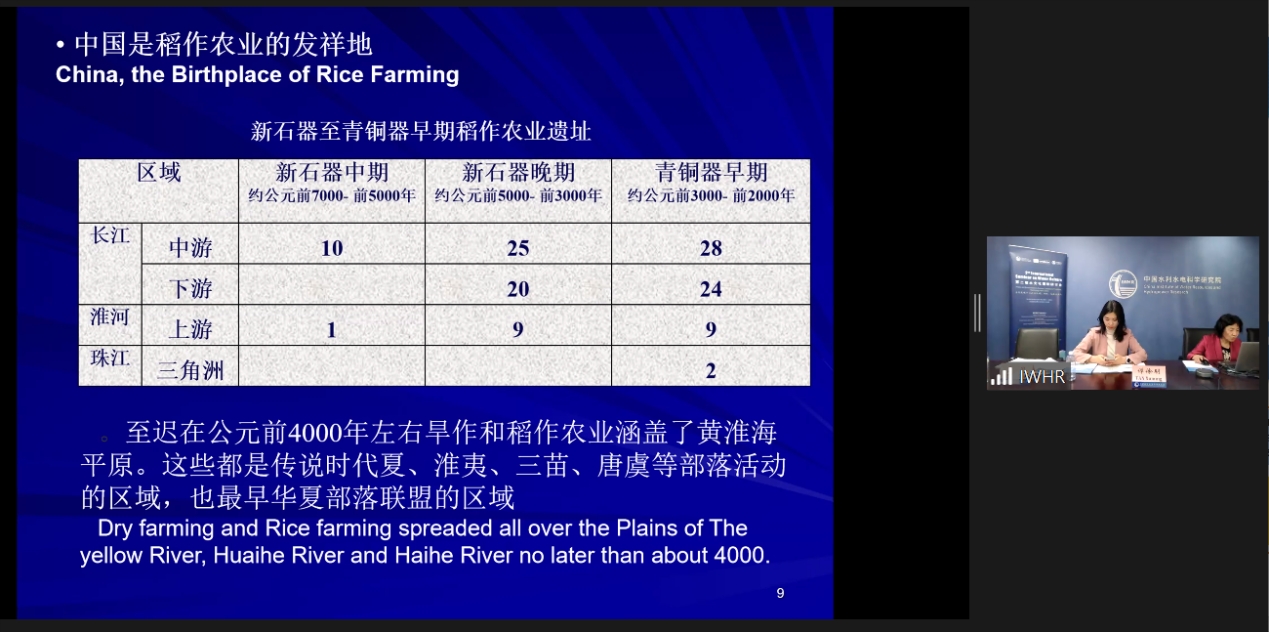
The origins of China are closely linked to water management, leading to many interpretations of "What is China?" and "What is Chinese civilization?" Yu the Great is a significant legend related to China's origins, often understood through the historical accounts of his efforts in flood control. Culture remains about Yu the Great are places where Yu once worked or where his deeds are recorded. Clarifying these remains provides deeper insights into the cultural value of Yu's flood control efforts.
The earliest records of Yu date back over three thousand years, with his flood control being the most famous legend. The earliest historical book in China, the Book of Documents (Shangshu), began documenting events related to Yu over two thousand years ago, recording his construction of numerous channels beyond flood management. This period also saw inscriptions detailing Yu's life. Han-dynasty stone carvings from Xuzhou illustrate the life of Yu from his birth to his achievements in flood control, marriage, and ascension to kingship. Between 1500 and 1000 years ago, records of Yu became more detailed, documenting both his achievements and lineage. The myth of Yu's flood control gradually refined over time, becoming clearer during the Ming Dynasty over five hundred years ago, where he was often depicted as the pioneer of water management. Following Yu's success, the Huaxia tribes transitioned to nationhood. Various tribes and dynasties then claimed descent from Yu to validate their legitimacy, resulting in numerous temples dedicated to him, Yu's Temples thus spread throughout China. The formation of national boundaries following Yu's flood control reflects China's geographical and cultural development. Yu's flood control narrative intertwines with five thousand years of Chinese history, embodying the cultural significance of his legacy.
Generally, Yu's flood control is a historical fact and a reflection of history, marking a pivotal moment in ancient Chinese civilization.
-- Tan Xuming, Professorate Senior Researcher, China Institute of Water Resources and Hydropower Research, President of the Water History Research Committee of the Chinese Hydraulic Engineering Society
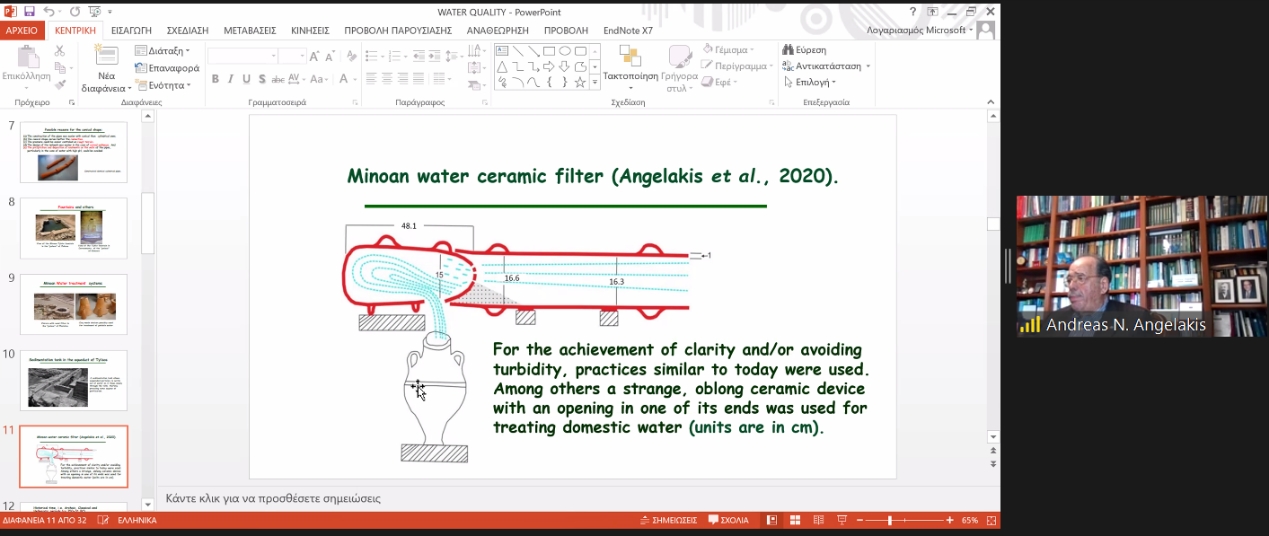
In the Minoan era, there were no nobles, kings lacked opulent palaces, and the church held no prominent status. People in that period lived equal lives. They ruled the Mediterranean for nearly 2,000 years, coexisting harmoniously with their surroundings. The water management and treatment systems during the Minoan era were highly developed, featuring a long water filtration system at the Palace of Phaistos, where water was filtered before consumption.
In the medieval period, scientific innovation and technological development slowed, resulting in a stagnation of water-related technologies. Similar to the medieval era, the Ottoman period saw limited advancements in water treatment and sanitation. However, in modern times, water technologies have taken a new step, with Athens completing its first sewage treatment plant in 1931. Yet, as of 2022, 2.1 billion people worldwide still lack access to clean and safe drinking water, with 3.4 million deaths annually due to waterborne diseases or water scarcity. Moreover, hundreds of millions of women and children spend 3 to 6 hours daily fetching water from distant, polluted sources, with half of the world's hospital beds occupied by patients suffering from water-related illnesses. Water quality significantly impacts the human lifespan and the WHO data indicates a substantial rise in global life expectancy beginning in the last century. However, Greece's life expectancy has slightly declined due to the COVID-19.
Future innovations in water purification technologies will boost advancements in solar energy, desalination, high-tech filtration, and nanotechnology. We must follow the trend and engage in profound discussions regarding water quality improvement and wastewater treatment.
-- Andreas Angelakis, Member of the Executive Committee of the International Water Association (IWA), Leader of the Specialist Group for Water and Wastewater in Ancient Civilizations
French Water Heritage: from Lutetia to Paris
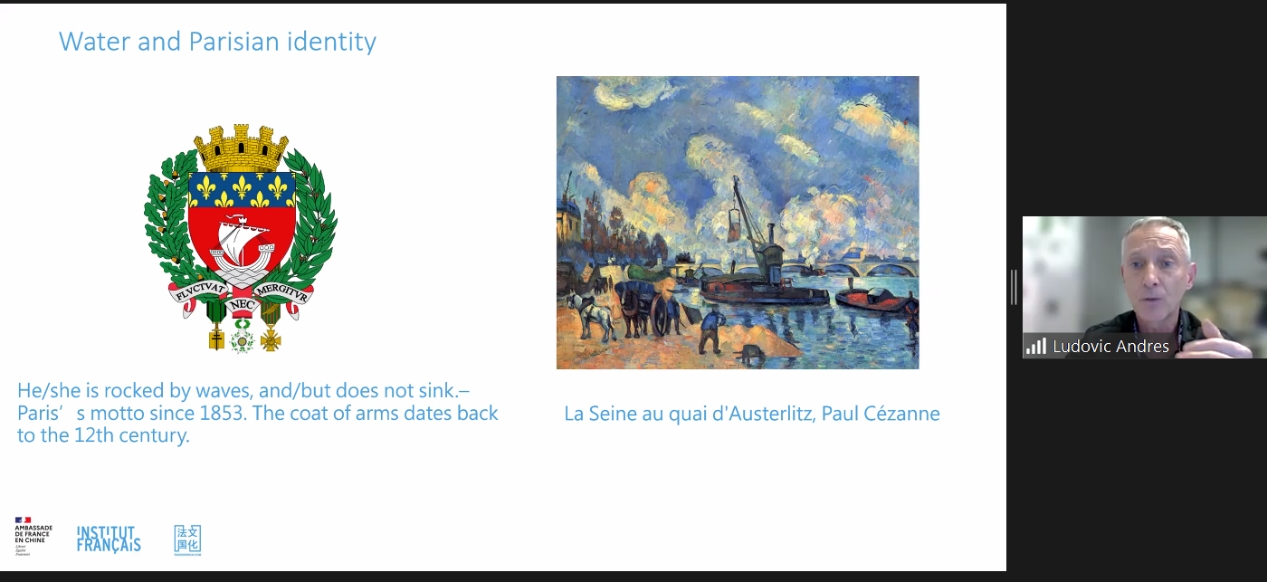
Paris is home to many water-related heritage sites, most of which are still functional. In a park 300 kilometers from Paris, at the source of the Seine River, stands a temple dedicated to Sequana, the goddess of the river Seine. Parisians regard this site as sacred. In the 2nd century, after the Romans occupied Lutetia (modern-day Paris), they constructed a 16-kilometer aqueduct along the river to supply water to public baths in the city center. This aqueduct remained functional for 500 years, with both its structure and remnants well-preserved. By the 5th century, Lutetia began to develop into present-day Paris. However, the water source is too remote to reach the city. Thus, in the 12th and 13th centuries, an underground waterway network was established, extending from a northeastern water source to the city center. Additionally, many wells were constructed, which, while ceasing to supply water in the 19th century, were well-maintained. In the 19th century, 29 pumps and aqueducts, with storage facilities known as the "Cathedral of Water," and the Wallace Fountain, a Parisian landmark, were built to alleviate water supply issues. All these structures either serve functional purposes or stand as heritage, recording the historical significance of water management in Paris.
The public enterprise Paris Water (Eau de Paris) is responsible for preserving and managing water heritage, overseeing maintenance, and optimizing management systems. The company also coordinates with farmers to promote organic agriculture while limiting chemical runoff, thus enhancing the urban ecosystem.
In France, beyond Paris, many other regions also possess water heritage, including traditional irrigation systems that are part of our water legacy.
-- Ludovic Andrès, Environmental, Heritage, and Tourism Officer, French Embassy in China
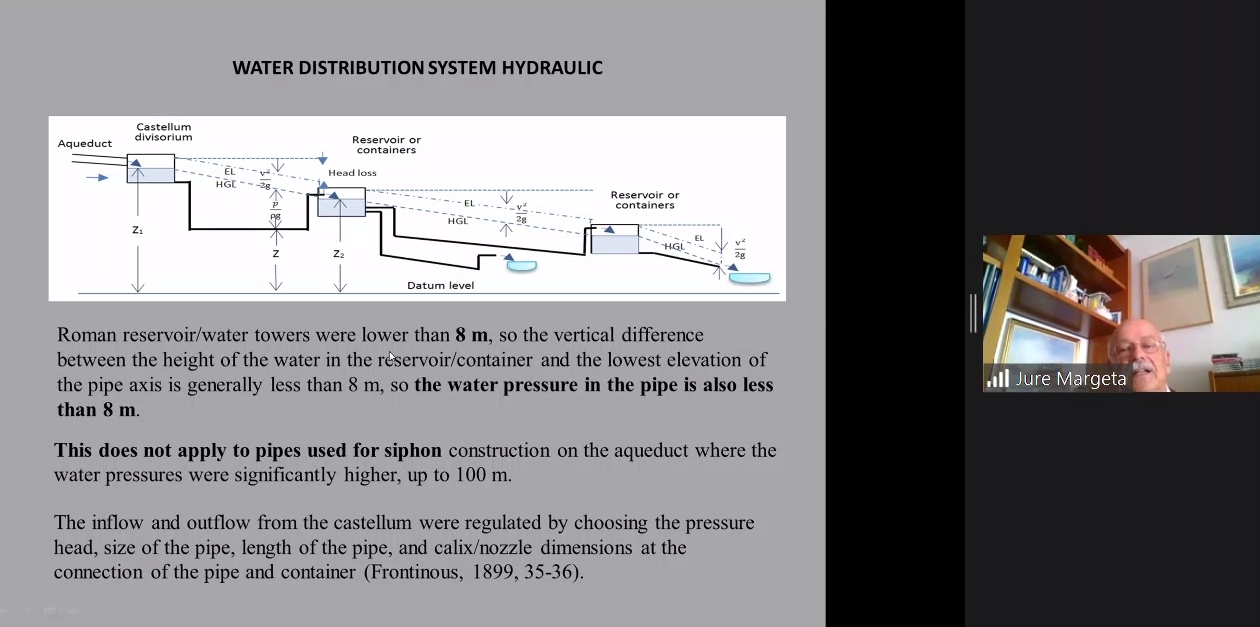
In 11 AD, Rome began using lead pipes in its water supply system, relying solely on gravity for water transportation, making it a fully green system. Lead, a by-product of silver smelting or an extract from ores, was chosen for its availability, resistance to water corrosion, and cost-effectiveness, making it an ideal material for pipes.
Research shows that the average thickness of Roman lead pipes was about 0.9 millimeters, resulting in minimal head loss. However, lead is toxic to humans, and prolonged exposure can cause health issues, particularly affecting the kidneys, with children and pregnant women being the most vulnerable. Lead pipes for water supply were phased out after 1970.
The joints in these pipes were crucial; poor connections could lead to water loss, which necessitated the development of advanced welding techniques by the Romans. Installation was equally important, and Roman city planning included strict requirements for pipe installation.
Experiments have demonstrated that Roman pipes, including their joints and seams, were effective and well-fitted. Fortunately, due to the short contact time between water and the pipes, especially in areas with hard water, lead contamination in the water supply system was not severe. As a result, this water supply system provided comparatively healthy drinking water for a long time, significantly improving hygiene and living standards in ancient Rome.
-- Jules Margita, Professor of Civil Engineering, Architecture, and Geodesy, University of Split, Croatia
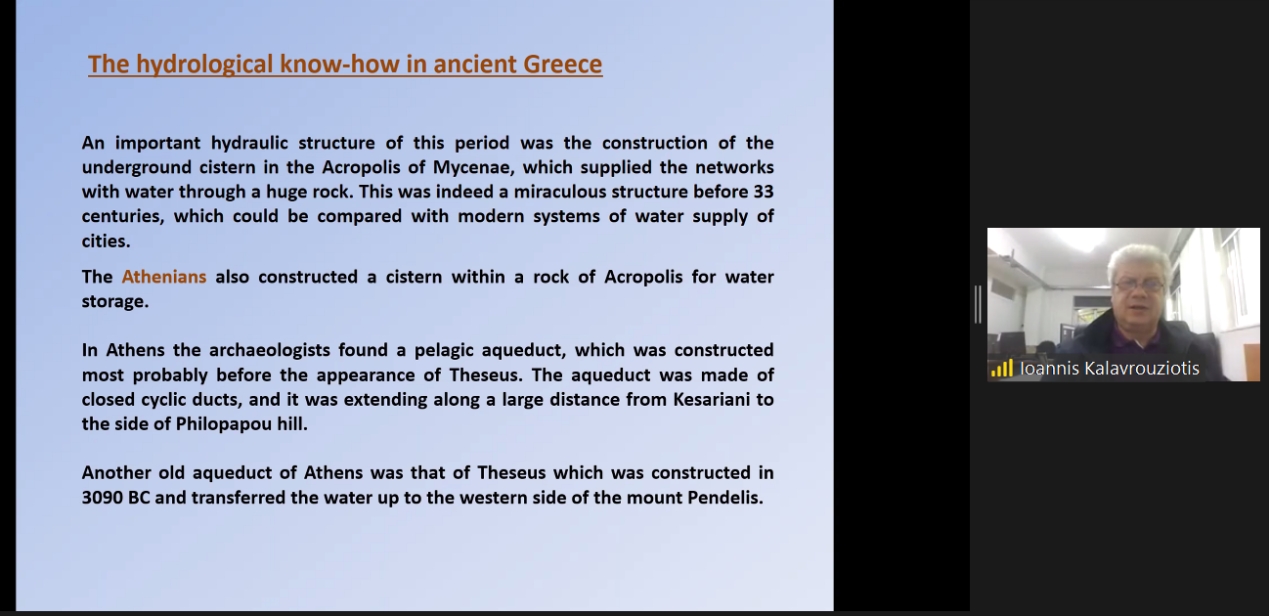
Ancient Greek hydrology and hydraulic technologies were exceptional, with complex sewage systems being constructed as early as 3000 BC. These systems provide significant insights into modern water management and hydraulic facility construction.
In ancient Greece, the primary considerations for building reservoirs, aqueducts, and other water facilities were the cost of materials, environmental sustainability, and durability—quite different from modern hydraulic structures, some of which have lifespans of only 50 years. In the Mycenaean civilization of western Greece, stone-built drainage systems were already in place by 3000 BC. The world-renowned Theater of Dionysus already addressed drainage and water recycling issues, using recovered water to irrigate surrounding gardens and farmland. By the Roman era, compared to those built in ancient Greece, the drainage systems had seen significant improvements, with embedded systems allowing household sewage to be discharged into the sea via underground drainage channels—some of which still function today.
In countries like China, India, Iran, and Jordan, ancient techniques similar to those of Greek civilizations continue to function, supporting the development of new technologies in these regions. These ingenious techniques have long been forgotten but gradually resurfaced over the past 200 years.
Western technological advancements have rekindled interest in ancient Greek civilizations, and their hydraulic technologies offer valuable lessons for modern-day systems. The superior performance of ancient Greek drainage systems demonstrates the merit of studying ancient water technologies.
-- Ioannis K. Kalavrouziotis, President, Hellenic Open University
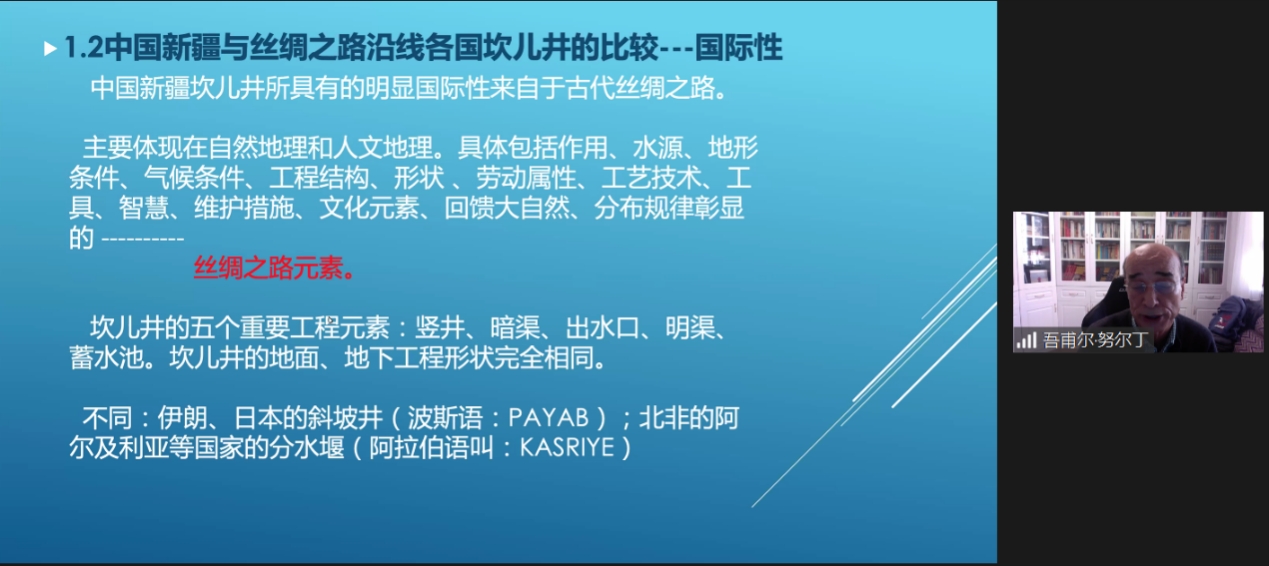
Karez systems are primarily found in countries along the ancient Silk Road. Currently, 24 countries have well-documented Karez systems, while 11 have incomplete data. In Xinjiang, Karez systems are concentrated in the Turpan region. Compared to tropical and subtropical regions with abundant rainfall, the Silk Road spans arid areas with scarce rainfall and limited surface water, making Karez an ideal system for guiding water sources.
A Karez well consists of four parts: the vertical well, the underground channel, the surface outlet, the open channel and the reservoir. The underground structures in different regions remain generally the same, while the surface structures differ, such as in Algeria, where water flow is managed by controlling the outlet and adjusting the amount of water through multi-level outlets. However, long open channels or irrigation ditches may lead to significant water loss due to evaporation and leakage. In Xinjiang, water is stored in small reservoirs at the end of the open channels, with sluice gates controlling water usage over time. This structure conserves water and regulates water levels.
In Turpan, Karez wells are the lifeline of the oasis. Each reservoir is surrounded by trees and villages, with the oldest tree near one reservoir revered by local farmers as a deity. They believed it would bless the Karez with a stable water source. Each country has its own name for the Karez. In Xinjiang, Central Asia, and Turkey, they are called "Karez," while in Spanish-speaking countries, they are named "Kanat."
Karez systems provide rich resources for nature, geography, culture, and history study along the Silk Road. Increased international cooperation and exchanges are encouraged to found the Karez studies, promoting international friendship and contributing to the Belt and Road initiative.
-- Gofur Nuridn, Executive Vice Chairman and Secretary-General, Xinjiang Karez Research Society
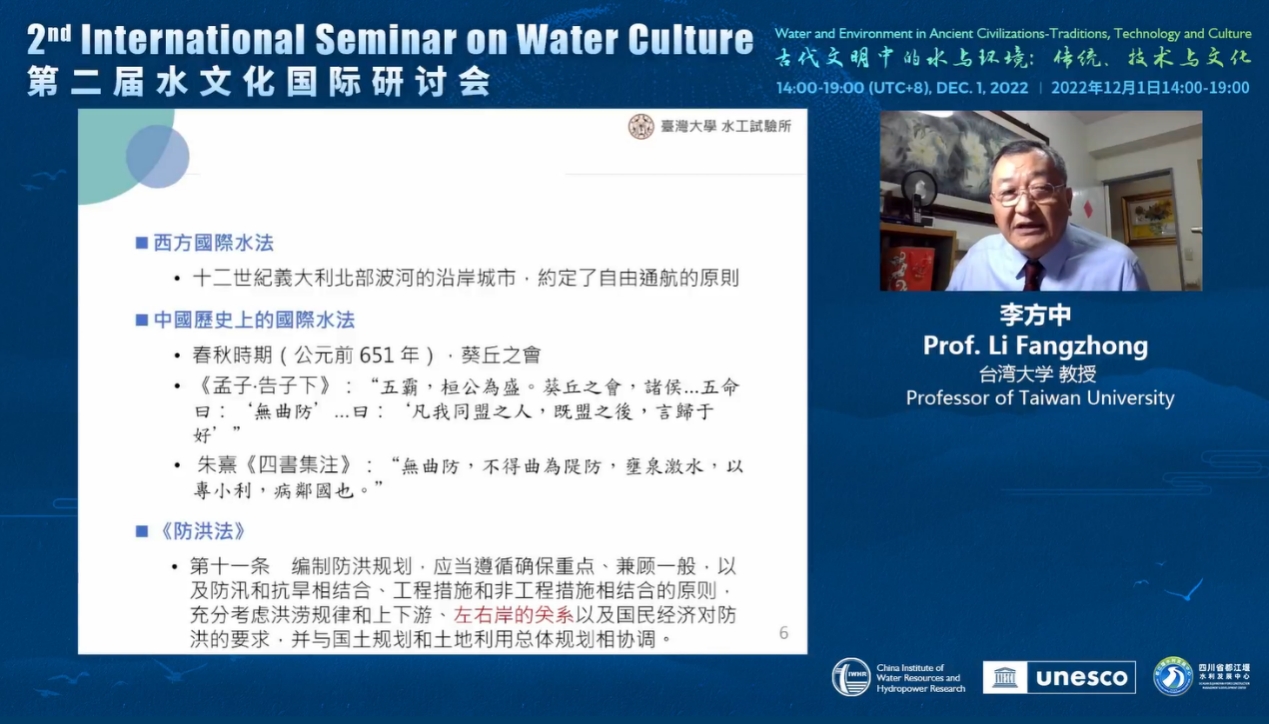
This study reviews the content and historical evolution of the Water Act (1942), the Water Law (1988), the Law on Flood Control (1998), with other national and international water laws.
Western international water law originated in northern Italy in the 12th century. In China, during the Spring and Autumn Period, the "Follow no crooked policy in making embankments" agreed at the assembly of the princes in Kui Qiu can be seen as an embryo of international water treaty. The spirit of this agreement is still evident in the Law on Flood Control. The Law on Flood Control stipulates the obligations of flood prevention and the right to mobilize materials, which are also regulated in the Water Act and Japan's River Act.
The fragmented Water Law of the Tang Dynasty already prescribed the order of water usage, while the History of Ming Dynasty - History of the Officials stated the priority of water usage for navigation, irrigation, and milling. During the reign of the Kangxi Emperor of the Qing Dynasty, the development of water resources in Taiwan was considered a civil matter, and disputes over water shortages were resolved through proportional distribution.
In modern times, the Water Act also sets out the priority of water usage, though the sequence has changed—navigation now follows domestic and public water supply. The Water Law prioritizes urban and rural water usage while considering other needs. The Water Act views water rights as private, while the Water Law has transitioned to a system of water abstraction permits.
In Taiwan, the practice of the Water Act has resulted in most water rights being concentrated in government agencies or enterprises. Hydraulic projects must undergo model experiments before construction, and post-construction effects must be observed to adjust accordingly. This legal characteristic is unique to water laws.
-- Lee Fang-Chung, Professor, National Taiwan University
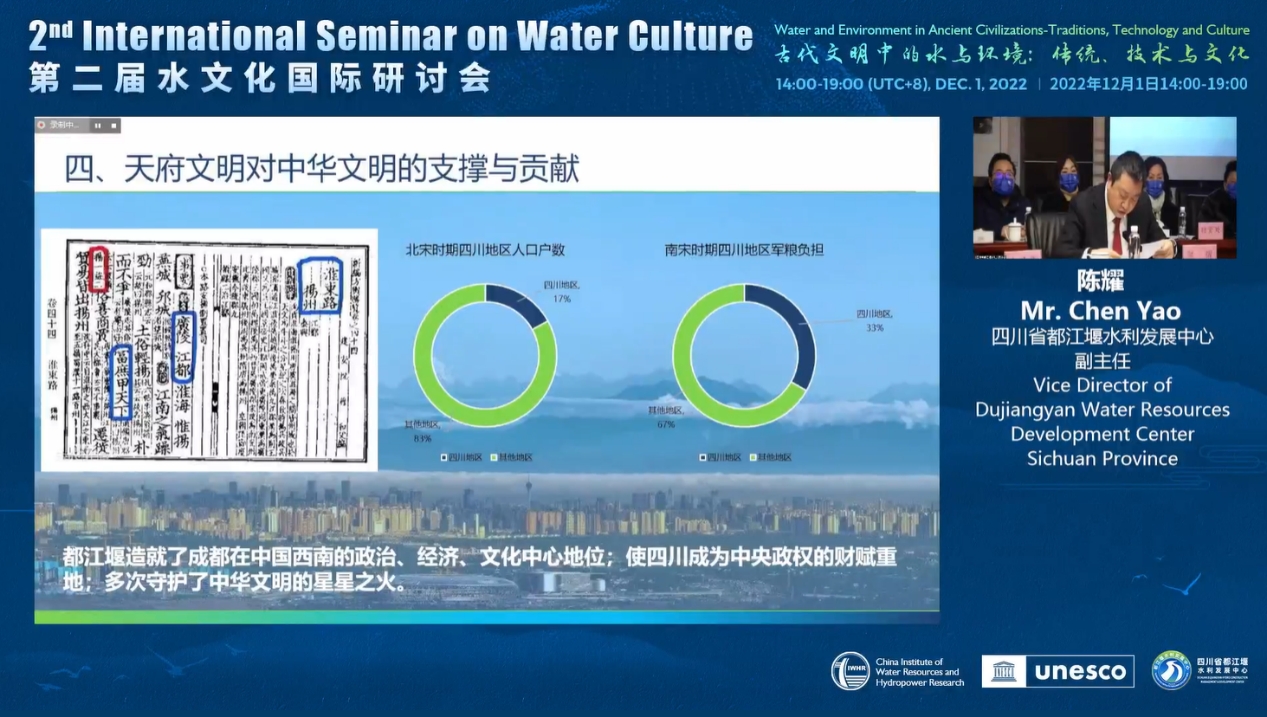
Dujiangyan is both a world irrigation engineering heritage site and a world cultural heritage site. For millennia, the Sichuan region, centered around the Dujiangyan Irrigation District, has played a vital role in preserving China's rich cultural traditions. It is the birthplace of the vibrant Bashu culture, characterized by its distinctive traits and enduring charm, which continues to exert a far-reaching influence today.
The Minjiang River nurtured the ancient Shu civilization, while the Dujiangyan system facilitated the prosperity of the Tianfu civilization. Under the nourishment of Dujiangyan, the Tianfu civilization made significant contributions to the broader tapestry of Chinese civilization. In peacetime, the abundant tax revenue generated by the Dujiangyan irrigation district, alongside contributions from regions like Jiangsu and Zhejiang, sustained the national government. During times of turmoil, Sichuan emerged as a refuge for Central Plains civilization and a strategic hub for its revival, influencing the course of Chinese history at critical moments.
Dujiangyan stands not only as a hydraulic hub and engineering marvel but also as a cultural symbol. The ideas, regional culture, scientific and technological advancements, and spiritual values embodied in Dujiangyan form an intangible heritage that transcends the physical structure. This foundational culture, born alongside Dujiangyan, is a vital component of Shu culture and an outstanding example of China's water culture..
—Chen Yao, Deputy Director, Dujiangyan Water Conservancy Development Center, Sichuan Province
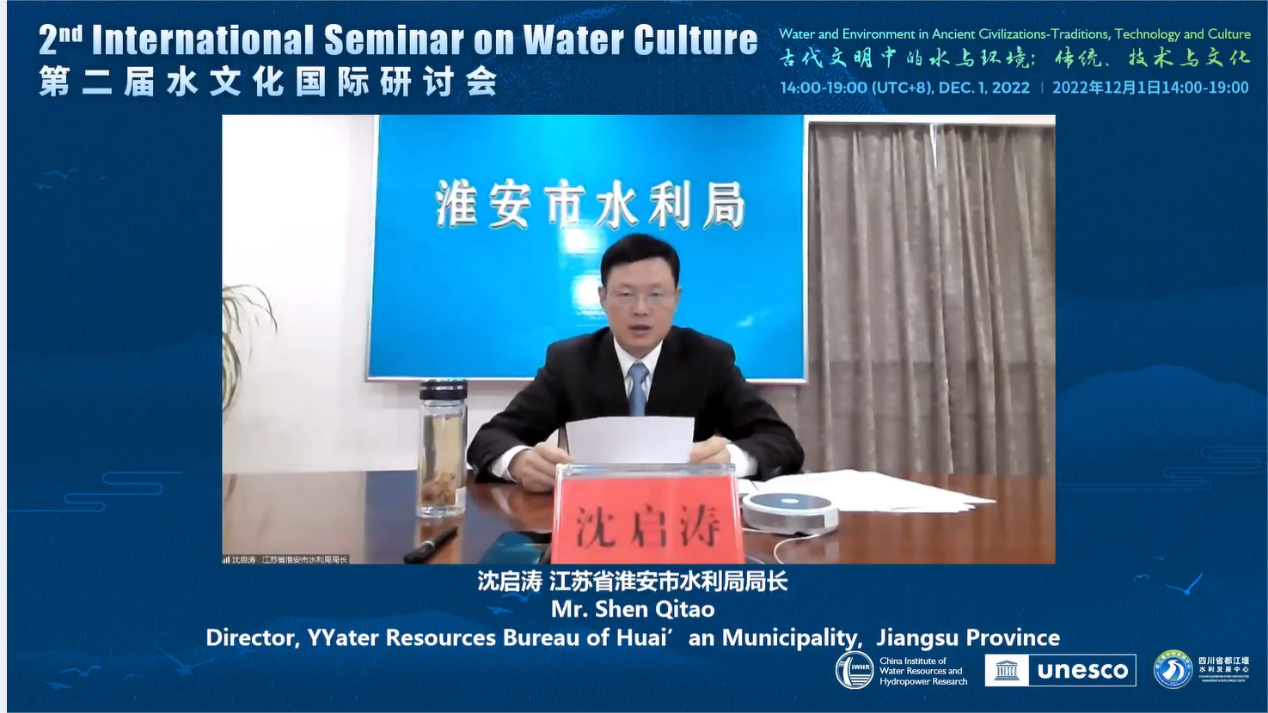
Located in northern Jiangsu Province, at the lower reaches of the Huai River and the midpoint of the Grand Canal, Huai'an historically served as the command center for national grain transportation during the Ming and Qing dynasties, earning the title "Capital of the Canal." However, it was also known as the "Flood Corridor" due to frequent flooding from the Yellow River breaching into the Huai River. Today, Huai'an has transformed into a vibrant region, rich in fish and rice. The region's unique geography and river-lake characteristics left a profound legacy of water culture and flood control.
As the only city where the Yellow River, Huai River, and Grand Canal converge, Huai'an's strategic location and diverse water projects have made it one of the most densely concentrated areas of hydraulic engineering since the Ming and Qing dynasties. It stands as a key cultural heritage site and a hub for water conservancy. The diversion of the Yellow River into the Huai River marked a pivotal moment, allowing Huai'an to emerge as a renowned "Flood Corridor." Benefiting from developments during the Ming and Qing dynasties, Huai'an increasingly became a key hub for water management. Highlighting contemporary developments, Huai'an has transformed into a livable land of fish and rice.
Thanks to its unique geographical location, extensive water engineering, and rich cultural heritage, Huai'an serves as a crucial hub for grain transportation, a vital area for flood control, and a core zone for cultural fusion between northern and southern China.
-- Shen Qitao, Secretary of the Party Committee of Huai'an City, Jiangsu Province, Director of Water Resources Bureau